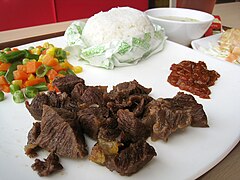Ingredients
The beef preferably used in this dish is beef shank. In There are several steps to prepare empal gepuk. First, the beef is boiled until medium well, then cut quite thickly along the muscle fiber into half-palm size. Then, using stone pestle and mortar, the beef pieces are beaten mildly to loosen the meat fibers and spread its size a little bit. The spices used in this dish are ground shallot, garlic, chili pepper, coriander, palm sugar, and salt, mixed with bruised lemongrass, galangal, daun salam (Indonesian bay leaf), a little coconut milk, and turmeric water. The meat pieces are cooked with the spices well until they are absorbed into the meat and the stock evaporate. Then the meat pieces are fried in coconut oil until the color darken and the meat is done. [1] Empal gepuk is sprinkled with bawang goreng (fried shallot) and served with steamed rice. This fried beef dish tastes succulent with mild sweetness acquired from palm sugar and a hint of spiciness.
This page is based on this
Wikipedia article Text is available under the
CC BY-SA 4.0 license; additional terms may apply.
Images, videos and audio are available under their respective licenses.



